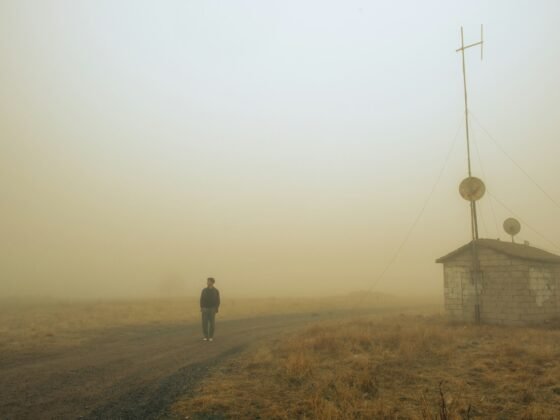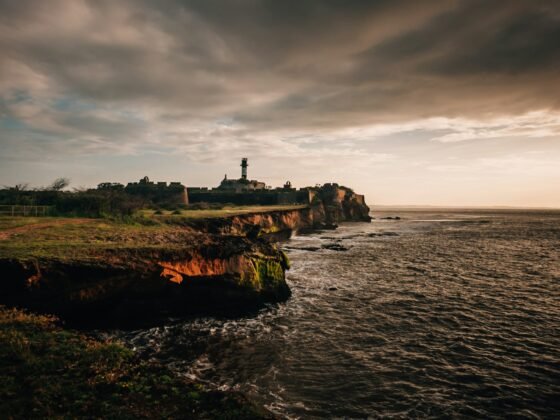by Sarah Hymas
PureTravel Writing Competition 2024 – Longlisted
I visited the High Arctic in 2018 with thirty other artists, on a repurposed brigantine that sailed us around part of the Svalbard archipelago. The sun did not set, merely rearranged the shadows of mountains, glaciers and moraines. What looked a few hundred metres away often turned out to be ten kilometres, or further. Million year old air hissed and popped from the bitty bergs we passed. I breathed in the exhalations of lives long gone. A glacier formed over four thousand years took five minutes to calve its front wall.
It wasn’t just me who shrank. Everyone on the boat was gawping and cooing before the deliberations of rock, ice, mud and water, reshaping before us. Every moment was an event, a first, that bore witness to the actions of the industrialised world.
No more so than the afternoon we headed for the rock at the northern tip of the archipelago. Rossøya is a low bulge of ancient continental crust three billion years old, once part of the earth’s mantle pressed upwards by magma, to aerate on release to the sky. It swelled white with snow, black in crevices threading across it, and green at its slimy rim. The threat of unseen ice meant the boat inched slowly towards it.
Prior to my visit, forecasts that by 2050 there’ll be regular ice-free summers were simply concepts. It might do this, it might do that. But surrounded by that mash-up of past with present, distance with proximity, the youth of humanity surged through me. Fifty one years old, and I felt such a child. I was floundering in a world that flipped me into unworldiness. I toddled on the deck, bundled in layers of fleece and thermals, legs outspread, keeping myself upright in the boat’s movement, dubious about getting too close.
We were in uncharted waters, literally, that afternoon. For years a lack of traffic made it unviable to survey much of the area. But since the seventies the ice melt season has lengthened, and more boats bring more tourists, scientists and engineers, all on their own missions. The previous year, apparently, the brigantine was unable to get as close to the rock as we were that day, because of sea ice.
We did have a chart in the deckhouse. Its blue paper was dotted with isolated depths, ranging from 64 to 117m. These constellated to the left of the yellow splodge that denoted Rossøya, the most northerly rock which lay a few millimetres above its neighbour. Easily a mile of uncharted water ran between the known depths and the rocks. And we were heading into it. But all I had to do was watch the first mate hold a plumbline off the bow, calling out depths as other crew manoeuvred us closer.
There was no sign of ice to the north. Around us each wave elbowed its predecessor, churning marine snowfall. Detritus from dead whales, fish and plankton, feed others in deeper water, or sediment and decompose into the seabed. Ocean as ossuary, as a site of continual dying.
My own watery body churned with the geological and historical weight of ice. I was unsure what I was doing there, consumed by overwhelm, by the general desire to reach the rock. It became irrelevant that I’d not heard of the rock previously. The feedback loop of ice melt, reducing the bounce back of the sun’s rays and increasing water temperature, span in circles around my own feedback loop of silence. All decision-making was in the hands of the skipper and crew. Approaching the rock, my doubt circled around my advance as a tourist and the retreat of ice.
But by the time the Zodiacs were lowered into the water, I was as excited to land on the rock as my fellow passenger. We split between two inflatables, everyone urging our boat forward, as the crew looked for possible landing sites, a sheltered nook, or snow-free ledge. No-one spoke as the boat nudged towards fissures and inlets. Foam veined the water around us. The rock glossed greenblack at the waterline, elsewhere thick icy crusts of snow.
Our collective will for it to open itself up to us was tangible as the throb of the outboard. We’d got this far. We were as good as there. Land was where we got to encounter what lived in the archipelago’s sea. The living generally kept themselves away from our lumberings. Apart from the walrus, who were docile and slow around our visitations – exactly what had made them such attractive prey back in the day. And this, the most northerly rock, held fresh promise. I borrowed a pair of binoculars and spotted a fox’s jawbone sticking upright in a crevice, just over an arm’s length away. Teeth jagged like the snowy mountains to the south. The intricate tubular cartilage of its small receptors were intact. The bone lacework was like bleached coral.
‘I touched it!’ the guide at the bow of the Zodiac screamed, waving her hand back at us. ‘I touched the rock!’ We all stared at her hand, then the rock, but already somehow the Zodiac was too far away for a second touch.
By the time the opportunity to go to Svalbard came, my desire to go had been a visceral urge for so long I couldn’t remember why I wanted to visit. I just urged to be North. I knew that wouldn’t cut it on my funding application, so wrote that the trip would allow me to research what was distant and unseen. That, to go somewhere unlike anywhere I knew, would help me to imagine a future disrupted by climate change. I promised to write conference papers, lead workshops, make poems, contribute essays and give talks. In return, the Arts and Humanities Research Council covered the cost of residency and flights.
For all my dreaming of the trip, I’d never experienced a land- or sea-scape quite so white. The peaks, plateaus, glaciers and surf were dazzlingly so. It reflected back at me my own whiteness. After all my form-filling I was wholly ill-equipped at what it presented to me. Unlike other species heading north in warming seas, I was there by choice. I’d wished and been granted. The grant even included an offset in my flight, but that didn’t fill my hollowness any more than there was ice to replenish the calving glaciers.
Whiteness is more than skin colour, it grants a power I was equally blind to. Going to the Arctic was a dream come true, and yet there it was clear the dream wasn’t mine. I’d been fooled into believing I could go where I wanted, supported and financed to uphold that belief. My desire was merely an extraction of the colonial dream, as much as that extracts pleasure from place, resource from material. It hadn’t been one of the guides of my group who’d shot dead a polar bear the summer I was there, but one guarding a party much like ours. We, like they, were just another bunch of wide-eyed tourists.
Of course it isn’t just the polar bears suffering. Global ocean currents are slowing with ice melt. The Gulf Stream and North Atlantic Drift could change direction at any time. A sudden collapse of these currents would impact all coasts, and further inland, bringing drought or flood to the unprepared.
Rossøya is named after James Clark Ross, a British explorer part of an 1827 expedition to reach the North Pole. Their ship got stuck in ice and never made it, but it did set a new record for reaching the furthest north than any previous expedition. This claim ignores that the rock may have been sighted in 1618 by a whaler, and was definitely marked, if unnamed, on a Dutch map of 1663. But there is it, named by the British on all maps. The rock’s claim as the most northerly of rocks ignores another outcrop slightly farther north, in the Russian Arctic.
Kittiwakes, guillemots, eider, giant skua, little auks and glaucous gulls do not care for names or league tables. Their cries were deafening that day, as they dove and called, searching for the gleam of fish coming for algae fertilised by their guano. Most of who’s indigenous to the rock comes via bird. Lichens and saxifrage were taking hold in the nooks of rock. Dimples of green filled many of the cracks. With the right conditions, of lichen, kelp, saxifrage, miniscule roots would become trunks, stamens and petals, thickening as soil in the years ahead, if uninhibited by ice.
Humans have come relatively recently to Svalbard. The earliest year-round trapping stations were built in the 1700s, first by Russian trappers then Norwegians. Mining and other mineral exploitation began in the 20th century. Nowadays, if you die and want to be buried on the archipelago you must apply with a good reason. There’s a partial midwifery service, but expectant mothers should travel to the mainland to give birth. Thinking about this policy of no birth no death added to my suspension of spacetime.
I lost count of how many times we circled Rossøya before our guides gave up trying to find a spot safe enough for us to climb ashore. The one patch where there was no slimy green algae was too icy. The decision was announced, the helmsman opened the throttle and we churned up water in the blades of our outboard.
Our setback was not life-threatening. We had the fuel to return to the brigantine. The rock, with its birds and snow and bones and crusted bulk, diminished into the horizon behind us. Not landing suddenly thrilled me. Algae, the smallest of inhabitants, nourishing everything else on the rock and the sea around it, touched fleetingly by the guide, had the power to deter us, keeping the act, our non-act, forever incomplete, open.
Photo by Jenny Zhang on Unsplash











